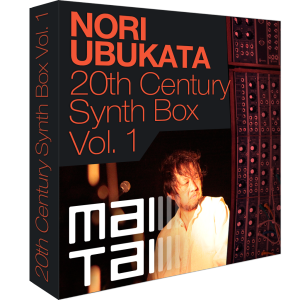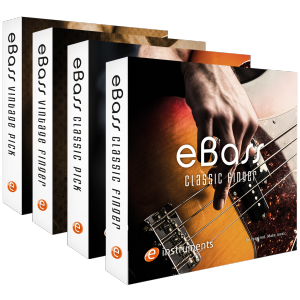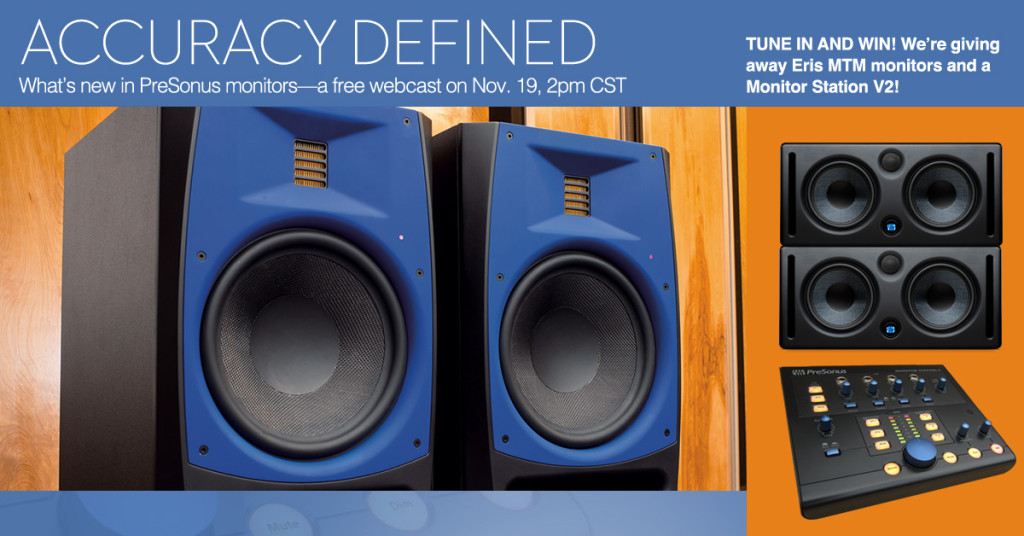Author Archives: Ryan Roullard
Review Of The E-Instruments eBass Complete Bundle from Studio One Expert
You can get the e-bass add-ons via our online store. Click here to shop.
Now Available: Nori Ubukata—20th Century Synth Box Vol. 1
We’ve got a new Mai Tai preset collection for Studio One 3 Artist and Professional! Take a trip back in time with Nori Ubukata’s 20th Century Sound Box and rediscover the legendary analog sounds of the 70s and 80s. Famed Japanese sound designer and synth/theremin artist Nori Ubukata recreated some of the most memorable sounds by electronic music artists such as Kraftwerk, Tangerine Dream, Vangelis and Wendy Carlos. The set contains a total of 111 presets and Instrument+FX presets (adding reverb, EQ and other effects). Also included are 50 Musicloops with sound elements showcasing the best presets in musical context.

Click here to buy it from our online store.
Beta Testers Needed for StudioLive RM Mixer Cascading
 Hey folks—the time has come to add cascading to the StudioLive RM mixers, and we’ve decided to run a public beta to stomp out any bugs before the update goes into wide release. We expect to have the beta concluded after around 30 days.
Hey folks—the time has come to add cascading to the StudioLive RM mixers, and we’ve decided to run a public beta to stomp out any bugs before the update goes into wide release. We expect to have the beta concluded after around 30 days.
With cascading added to the RM series, users will be able to combine two RM32AI mixers for a 64-channel mix system to be controlled via the StudioLive CS18AI or UC Surface. You’ll also be able to cascade any two RM mixers, allowing for an RM32AI and RM16AI to work in tandem.
This update will also add:
- A new Stage Box mode for using RM mixers as a simple I/O device with Studiolive AI console mixers
- New network configuration interfaces and networking features for AI Consoles, RM mixers, and the CS18AI, including the ability to manually assign static IP addresses.
- Remote control of Capture 2 from both the CS18AI and UC Surface.
- AI Console, RM mixer, UC Surface and Capture 2 performance improvements and bug fixes.
Sound fun? You’re welcome and encouraged to join in! All you need to do is register your
StudioLive AI Console, RM mixer, or CS18AI to your user account at my.presonus.com, and you’ll then have access to the StudioLive AI Public Beta section of the PreSonus forums. Note that only users who have registered a qualifying product will have access to the beta section of the forum.
Please know that with beta firmware and software, there is always a risk of encountering a bug, so we don’t recommend using the public beta firmware and software for mission-critical gigs without first testing it out in a non-production scenario. Also, we ask that all questions and bug reports for public beta issues be directed to the public beta forum, and not via technical support tickets or calls. Tech Support will not be able to assist with beta software and firmware.
Free: Recording in Studio One Made Easy
Getting started with home recording just got a whole lot easier this holiday season. Purchase any PreSonus audio interface and register it at my.presonus.com before January first and you will receive the Recording in Studio One Made Easy course from Home Recording Made Easy.
Home Recording Made Easy will teach you on how to do everything from hooking up your hardware to your computer, recording an entire song using a modest recording studio set-up and finally mixing that song using the tools in Studio One.
This series is nearly 3 hours in length and has 10 video sections. Whether you have switched from another DAW to Studio One or if you are brand new to home recording this series is for you. This is also the perfect enhancement when giving the gift of recording this Holiday Season.
Introducing the eBass Add-ons for Studio One 3
 [This just in from Thomas Koritke of e-instruments, who shared some valuable insights on the creation of our new eBass Add-ons for Studio One 3! These sample packs include VERY meticulously sampled recordings of a 1975 P-Bass in various styles. They’re available for all editions of Studio One 3: Artist, Professional, and Prime, and can be purchased on shop.presonus.com website or directly from inside Studio One.]
[This just in from Thomas Koritke of e-instruments, who shared some valuable insights on the creation of our new eBass Add-ons for Studio One 3! These sample packs include VERY meticulously sampled recordings of a 1975 P-Bass in various styles. They’re available for all editions of Studio One 3: Artist, Professional, and Prime, and can be purchased on shop.presonus.com website or directly from inside Studio One.]
We are really happy to see our eBass released! I hope the following gives you some valuable information on our instruments.
We recorded a 1975 Precision Bass in a studio here in Hamburg—actually the same studio that we used to record our Session Strings, Session Horns and Session Keys instruments. It is one of the few facilities left with a large and great sounding room.
We used a Millenia TD-1 tube channel for the Vintage Bass instruments, and an Avalon DI preamp for the Classic Bass. We also recorded the bass via an Ampeg SVT top with 112 speaker, just as a sound reference. However, we ended up using only the DI signals for our eBass instruments. The DI signal provides great flexibility for additional processing with amp simulators and EQ, so the reference amp recording was a tremendous help when we designed the Instrument+FX presets—we could always compare them to the real thing. Strings were medium 045-105 round-wound for the classic and the same gauge flat-wound strings for the vintage. The pickup set was the original from 1975.
The bass was performed by a completely unknown, but extremely patient bassist here from Hamburg. Sampling requires a very special skill set and what we ask a musician can be quite hard or boring for a famous virtuoso. The player has to be able to have great control over dynamics and sound as well as keeping a certain dynamic throughout the entire tonal range. He has to be very patient and controlled, should not produce any noise, should not move, and has to repeat notes several hundred times… it’s a painful process, but it’s worth it: with both flatwound and roundwound strings and two playing styles—pick and finger—for each string type, eBass provides THE classic Precision Bass sounds.
Despite the previously mentioned attention to details, I think the most interesting part of the product is in its scripting, sound design, and music loops. Our goal is to provide very flexible and easy to use great sounding bass sounds. As such, we designed these Add-ons with presets for different use cases. Some people love to perform a bass line on a keyboard. The performance presets are designed specifically for that. They include an intuitive legato function (legato on the same string–within a fourth interval), velocity switching for dead notes or harmonics, pitch bend control to trigger slides and hammer-on/pull-offs and even control over the left hand position on the neck via mod wheel. All articulations are instantly available.
Other producers are used to selecting different articulations via key switches. We have created the production presets for them. Here, all articulations are accessible via dedicated keyswitches. The production presets also feature left hand position control via mod wheel. Both preset types are available as “dry” Presence XT presets, or as Instrument+FX presets including a chain of Ampire, EQ and Compressor.
Finally, some musicians may just need some inspiration or use an existing bass line and modify it. Each eBass includes Musicloops in different styles, genres and complexity levels – from fairly basic to quite busy. They all come with a dedicated effects chain setting to match that specific style or genre.
All the best,
Thomas Koritke
e-instruments
DigiMax DP88 – A Legend Remade
The DP88 is here!
Introducing the DigiMax DP88—an 8-Channel A/D/A Converter with remote controllable preamps. The DP88 is the perfect compliment to PreSonus’ Studio 192—among other interfaces.
Paul Wright and Studio One
 After starting his career more than twenty years ago, Paul Wright finds himself with a trophy case of accomplishments. A multi Grammy, Dove, and Stellar award winner and nominee, Wright has worked on over 200 records as a writer, producer and composer. He’s been fortunate enough to work with the Brooklyn Tabernacle Choir, Donnie McClurkin, Fred Hammond, Gary Chapman, AsOne, Disney and many more. His film and television projects include: Made In America, Preaching to the Choir, Full House, and Martin—where he co-penned the theme song. Through his career, he’s held titles at Benson Records, Verity/Zomba, Harborwood/Zomba/BMG, and Nuspring/EMI. He’s currently the CEO of 360MusicWorx/Capital Christian/Universal Music.
After starting his career more than twenty years ago, Paul Wright finds himself with a trophy case of accomplishments. A multi Grammy, Dove, and Stellar award winner and nominee, Wright has worked on over 200 records as a writer, producer and composer. He’s been fortunate enough to work with the Brooklyn Tabernacle Choir, Donnie McClurkin, Fred Hammond, Gary Chapman, AsOne, Disney and many more. His film and television projects include: Made In America, Preaching to the Choir, Full House, and Martin—where he co-penned the theme song. Through his career, he’s held titles at Benson Records, Verity/Zomba, Harborwood/Zomba/BMG, and Nuspring/EMI. He’s currently the CEO of 360MusicWorx/Capital Christian/Universal Music.
We recently asked him about his experience with PreSonus and Studio One. With his years of experience recording and producing music, Wright knows what tools work best for him.
“Studio One came to my life when I knew I wanted to switch DAWs,” Wright says. “I was a longtime Pro Tools HD user and at that time I had a commercial facility. One thing that bothered me with most DAWs I was using was that they were NOT composition friendly. There’s usually a learning curve that kills the creative process because of the number of steps it takes to do the simplest of tasks. I found myself wasting time figuring out how to make the DAW do what I wanted—I spent more time clicking buttons than actually being creative and making music!”
After making the switch to Studio One, things were different—almost overnight. “Everything instantly became more productive for me on many levels. Composing, production, recording–it was a life changer. I found myself turning out projects more quickly and easily.”
When it comes to why Studio One is the best for Wright, it all comes down to quality and speed. “First and foremost? Audio quality. I found myself getting my work to sound great in less time using less plugins and processing,” Wright asserts. “As a composer and producer that uses many virtual instruments, the ability to get my MIDI converted to audio quickly was huge for me! Now in Studio One, the expanded Arranger features are killer, as well as the Scratch Pad. I also noticed that the mastering features were exactly what I needed, and in several cases have mastered many projects right in Studio One.”
Wright’s attempt to create an ideal workflow by using multiple DAWs was not void of challenges. “I used Pro Tools, Nuendo, and Studio One all at the same time, utilizing each of them individually to get what I was after,” Wright recalls. Nuendo was my mix platform, Pro Tools was for converting sessions coming in from other musicians, and Studio One was for everything else.” After completing an A/B test regarding sound quality, Wright found Studio One and Nuendo on top.
Wright suggests that “the only downfall for Studio One versions 1 and 2 was the mix features and the inability to easily connect them to other controllers.” He goes on to say, “I found that working with the SSL Matrix as my main console and controller, it wasn’t working the way I had hoped. However, with the recent release of Studio One 3, it looks like my SSL is working better than ever and I am loving what I am seeing”
Wright closes with a challenge.
“Studio One has changed the game for me personally, and is worth checking out if you haven’t already. I would challenge anyone regardless of the DAW they currently use, give Studio One a shot and watch it change the way you make music!”
Give As One a listen here.
PreSonus LIVE airs today: Accuracy Defined—What’s New in PreSonus Monitors
Join Justin Spence as he takes us on a tour of the latest monitoring offers from PreSonus: the R Series monitors and the Eris MTMs! He’ll also talk about monitor setup and monitor controllers like the Central Station and Monitor Station.
TUNE IN AND WIN! We’ll be giving away a pair of Eris MTM monitors and a Monitor Station!
Jake Owen: on the Road with PreSonus!
Jake Owen is in the enviable stage of his career where he can work with whatever gear he wants. As such, we’re flattered that he’s taking a complete PreSonus recording rig on his tour bus that includes Studio One, Sceptre Monitors, ADL preamps, and much more. Any musical idea that his band has during impromptu jams can be recorded right on the road, without needing to stop in a recording studio!
For more on Studio One, click here.

